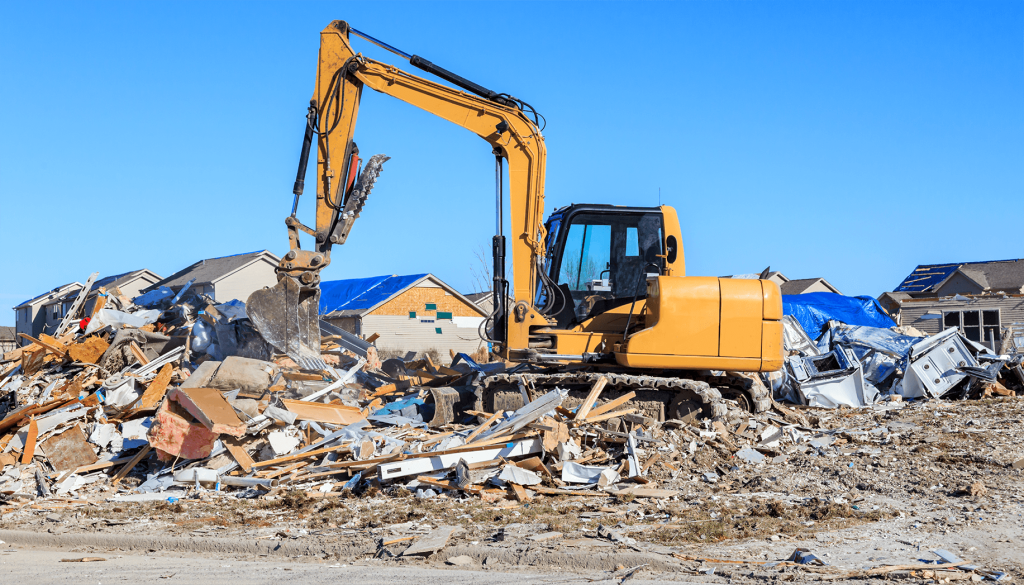Every year, communities across the country are impacted by disasters such as hurricanes, tornadoes, floods, wildfires, and winter storms. With these natural events comes debris. Debris management is often one of the most overlooked and least-planned-for components of disaster response and recovery — despite that it can be one of the costliest resulting expenses.
According to FEMA.gov, in 2022 debris removal and monitoring (FEMA PA Category A) has accounted for 55% of recovery costs for disaster events (COVID and non-debris generating events excluded). In less than five months, from January 1 to April 21, the Federal Emergency Management Agency (FEMA) has obligated $15.8 million for 26 projects.
A large percentage of Public Assistance (PA) recovery costs are consumed solely by Category A Debris Removal. Still, many local and state governments continue to overlook and are underprepared for debris removal and monitoring.
What is Debris Monitoring?
After a disaster is federally declared, funding from FEMA’s Public Assistance Program under Category A is made available to reimburse recipients and subrecipients to cover debris removal. But what exactly is considered debris removal?
Debris removal is the clearance and/or disposal of hazardous items such as trees, limbs, building components, vehicles, vessels, and other forms of personal property.
For debris removal to be eligible for Public Assistance funding, the debris must be a direct result of the federally declared disaster, the applicant must have a legal obligation to remove the hazardous items, and the removal must:
- Eliminate an immediate threat to lives, public health, and safety; or
- Eliminate direct threats of significant damage to improved public or private property; or
- Ensure the economic recovery of the affected community to the benefit of the community-at-large.
FEMA requires that all contracted debris removal be monitored to:
- Avoid fraud or waste.
- Ensure that the removal contractor is performing the scope of work agreed to with the mutual client.
- Document the debris removal operations per the funding agency’s requirements.
The primary role of debris monitors is to confirm debris eligibility by documenting the debris’ type and location, who it was removed by, where and how it was disposed of, and the volume of debris collected.
There are generally two sites where debris removal will take place: public property and private property.
- Public property debris removal will take place on the applicant’s rights-of-way and public property that the public can access, such as parks, cemeteries, and open spaces.
- Private property debris removal will only be made eligible when the damage from a disaster is so widespread that removal of debris from personal property is necessary for the benefit of the community, not just a single household or small group of households.
Debris Management Starts Before a Disaster Strikes[1]
Formulating a debris management plan before a disaster strikes helps identify and resolve potential issues that might arise ahead of time, such as the responsibility of public works, fire department, or emergency operations center (EOC) immediately after a debris generating event, without the pressure and time constraints faced in the immediate aftermath of a disaster.
Furthermore, having a detailed plan minimizes response times and maximizes recovery efforts.
Elements to have in the plan:
- Designated disposal or staging areas.
- Permitting issues.
- Prioritized list of routes that need clearing.
- Documentation stating that the debris monitoring will be done.
If there is no debris management plan when a disaster strikes, an applicant has several options:
- Use force account labor (e.g., an applicant’s employees) for the debris removal; however, only overtime labor and the hourly or rental cost of equipment is eligible for FEMA reimbursement.
- Use a mutual aid agreement with the state or local governments. Each mutual aid agreement is different; consequently, FEMA funding will depend on the terms and conditions of the contract.
- Hire a contractor to perform debris removal. FEMA will reimburse at least 75% of the eligible cost when a debris contractor is utilized, as long as proper procurement procedures are followed.
Special Handling Requirements[2]
Regardless of the triggering event, debris has the potential to contain regulated material that requires special handling to comply with federal, state, and local regulations. If the debris is not handled and disposed of properly, penalties may be imposed and could lead to denial of FEMA funding.
Common types of debris requiring special handling are:
- Construction and demolition (C&D) debris containing lead paint or asbestos.
- Paint, gas, solvents, and other hazardous materials.
- Computers, televisions, and other electronic components and supplies.
- Stoves, refrigerators, and other major appliances.
Procurement
Proper procurement is essential to ensure that an applicant will retain any FEMA funding for eligible work. A review of the procurement process is the starting point of any audit, and federal requirements in 44 CFR (Code of Federal Regulations) and 2 CFR Part 200 provide guidance on emergency management and assistance and federal procurement policies.
FEMA Grants Manager and Disbursement of Funds
Before the debris removal operation is completed, local governments should be prepared to submit their documentation for a request for reimbursement for the debris removal and monitoring costs.
This requires the completed Project Worksheets and assimilation and scanning of your documentation, which are uploaded into FEMA Grants Portal, “the forward-facing platform used by state, local, tribal, and territorial (SLTT) governments and eligible non-profit organizations to manage grant applications.”[3]
Documentation requirements include:
- Load ticket data
- Field logs and reports
- Timesheets
- Truck certifications
- Contracts and procurement documents
- Invoices and proofs of payment
Once a local government uploads the necessary documents, it is their state’s responsibility to review the documentation for completeness and accuracy before passing them to the FEMA Consolidated Resource Center (CRC), where the information is reviewed to verify the scope of work and validate the submitted costs.
When grant funding is allocated to the state agency, the agency may conduct another review before issuing financing to local government agencies.
Conclusion
When a disaster strikes, it is almost certain that debris will be generated. From the initial clearing of vegetative debris to accommodate emergency vehicles to the demolition of severely damaged homes, having a detailed debris-management plan can ensure compliance with FEMA’s Public Assistance Program and, therefore, reimbursement for debris management and removal expenses.[4]
[1] Disaster Recovery Issue #13: Proper Debris Management – Key to Disaster Recovery and FEMA Assistance
[2] Disaster Recovery Issue #13: Proper Debris Management – Key to Disaster Recovery and FEMA Assistance
[3] FEMA Fact Sheet, 2019 Grants Manager And Grants Portal Fact Sheet (FEMA.gov)
[4] Disaster Recovery Issue #13: Proper Debris Management – Key to Disaster Recovery and FEMA Assistance
Featured Experts

Chris Denney
Chris Denney is an established emergency management professional with over 17 years of experience in debris management, project management, data management, and disaster response. He is thoroughly trained in disaster debris monitoring processes, procedures, and best practices.
He has successfully led personnel for many debris monitoring operations including major hurricanes, floods, ice/winter storms, tornados, and oil spills. He has managed and secured funding for more than 10 million cubic yards of disaster-generated debris.



